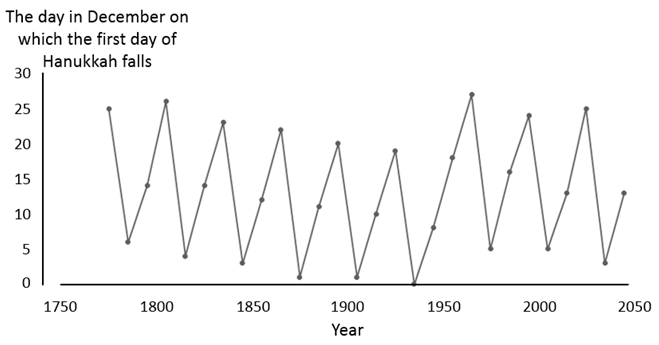
This year the first day of the Jewish festival Ḥanukkah falls on the first day of Christmas. Call it “Chrismukkah”, if you like. [The letter Ḥ is pronounced like the ch in loch.] This occurs only once every 30 years on average, and this is only the eighth time they have coincided since 1777.
The Jewish calendar, a primarily lunar one, has 12 months of 29 or 30 days each. In order to catch up with the solar calendar seasons there is an extra month in lunar leap years, which occur seven times every 19 years, determined by the Metonic cycle, named after Meton, a Greek astronomer of the 5th century BCE. Meton noticed that a period of 19 years, each lasting 365.2425 days, is almost exactly equal to 235 lunar months, each of 29.53059 days, 6940 days in all; the difference is only 0.0027 of a day (4 minutes). The Metonic cycle is also called enneadecaeteris, from the Greek ἐννεᾰκαιδεκα-ετηρίς, a period of 19 years. Callipus of Cyzicus (fl. 330 BCE) took one day away from every fourth Metonic cycle, giving the more accurate 76 year Calippic cycle.
The first day of Ḥanukkah occurs on the 25th day of the month called Kislev, so it is appropriate that it sometimes falls on the 25th of December. The figure shows the days in December on which the first day of Ḥanukkah has fallen in every tenth year since 1777. The earliest date on which it can fall is 27 November and the latest 27 December. It has fallen in November only 23 times since 1777.

Figure. The days in December on which the first day of Hanukkah has fallen or will fall every tenth year from 1777 to 2047. Zero indicates a date in November (the 29th in 1937).
The festival commemorates the Maccabean War in 165 BCE, when the Jews, led by Judah Maccabee, led a successful rebellion against the Syrian king Antiochus Epiphanes, by whose orders a shrine to Zeus Olympius had been established in the holy temple of King Solomon in Jerusalem. The temple was retaken, ritually cleansed, and rededicated. In the book of the Maccabees, part of the Apocrypha, we read that there was only enough consecrated oil to keep the נר תמיד (nehr tamid), the everlasting lamp, burning for one day. However, the oil miraculously lasted for eight days, until a further supply could be obtained. Ḥanukkah is therefore also called the Feast or Festival of Lights and is celebrated for eight days.
The story of the war is recounted in Handel’s three act oratorio, “Judas Maccabaeus” of 1746, based on a libretto by Thomas Morell. The music that Handel set to See, the Conqu’ring Hero Comes! is used for one of the songs sung during the festival, when candles are lit, one on the first evening, two on the second, and so on, up to the full eight. A special eight branched candelabrum, called a ḥanukkiah, is used; it should not be confused with the seven branched menorah, which is a different symbol.
“Ḥanukkah” is a transliteration from the Hebrew, חנוכה, which means dedication, from a Semitic triliteral root, ḤNK, meaning to make to understand or train. Add it to the word for a house and you get a phrase, חנוכת בית (ḥanukat bayit), meaning a housewarming, a type of dedication. The words “menorah”, a lamp, and “nehr”, a candle in modern Hebrew, both have a triliteral root, NWR, meaning to shine, also the source of “minaret”, from the Arabic manāra, a place where a light is established.
Christmas and Ḥanukkah also coincide medically. Christmas disease, a bleeding disorder similar to but distinct from haemophilia, was first recognised in 1952 by Rosemary Biggs, at the Radcliffe Infirmary in Oxford, and her colleagues. They described seven patients and called the disease after one of them, Stephen Christmas. The missing clotting factor was later designated Factor IX or Christmas factor.
When Gershenfeld and Weissman cloned the gene for a trypsin-like serine protease from a murine cytotoxic T-lymphocyte cDNA library by an RNA hybridization competition protocol, they found that it had a nucleotide sequence similar to that of the Christmas factor gene; they called the protease Hanukah factor. They and their colleagues later found a human equivalent, with a gene located on chromosome 5, homologous with the granzyme A gene on mouse chromosome 13. They suggested that the Hanukah factor might function as a common component necessary for lysis of target cells by cytotoxic T lymphocytes and natural killer cells. They later showed that together with other granule proteases it makes up a family of fragmentins that activate DNA fragmentation and apoptosis, programmed cell death. Which is strange, since Christmas and Hanukkah are times for celebrating birth and restoration.
Jeffrey Aronson is a clinical pharmacologist, working in the Centre for Evidence Based Medicine in Oxford’s Nuffield Department of Primary Care Health Sciences. He is also president emeritus of the British Pharmacological Society.
Competing interests: None declared.
